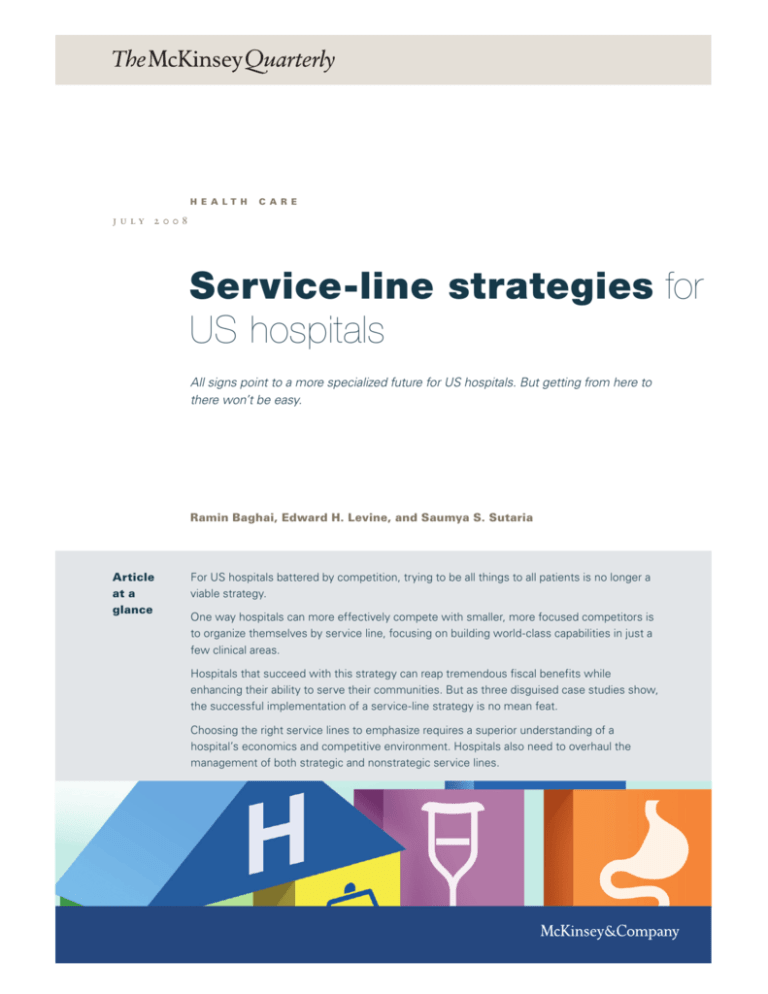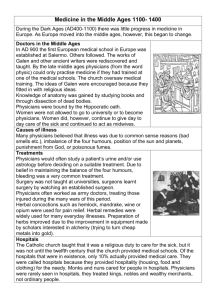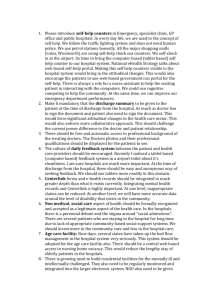
h e a lt h
c a r e
july 2008
Service-line strategies for
US hospitals
All signs point to a more specialized future for US hospitals. But getting from here to
there won’t be easy.
Ramin Baghai, Edward H. Levine, and Saumya S. Sutaria
Article
at a
glance
For US hospitals battered by competition, trying to be all things to all patients is no longer a
viable strategy.
One way hospitals can more effectively compete with smaller, more focused competitors is
to organize themselves by service line, focusing on building world-class capabilities in just a
few clinical areas.
Hospitals that succeed with this strategy can reap tremendous fiscal benefits while
enhancing their ability to serve their communities. But as three disguised case studies show,
the successful implementation of a service-line strategy is no mean feat.
Choosing the right service lines to emphasize requires a superior understanding of a
hospital’s economics and competitive environment. Hospitals also need to overhaul the
management of both strategic and nonstrategic service lines.
The full-service, general hospital— still the mainstay of US acute-care delivery—is
under attack. Immense clinical complexity; the advent of performance transparency
for evaluating quality, service, and costs; and growing competitive intensity are
challenging the notion that any hospital can excel across a broad spectrum of clinical
service lines.1
Consider a US hospital of average size, with roughly 160 staffed beds and a mean
daily patient census of about 100. On any given day, it might admit only a handful of
patients with similar conditions. Contrast this with the current crop of
sophisticated, focused, multispecialty institutes for heart, cancer, or neurological
care: they treat up to several hundred patients each day. “Pure play” specialty
hospitals and outpatient centers with low-cost structures, limited complexity, and
focused, high-quality service are also emerging. Competitors like these are raising the
performance bar for general acute-care hospitals and, in some cases, posing serious
questions about their sustainability.
While traditional general hospitals are unlikely to disappear anytime soon, a new
approach—a commitment to clinical service lines as an organizing paradigm, much
as many corporations organize themselves by business unit—is becoming a necessity
for many such organizations.2 Specializing in a few service lines allows hospitals to
build a critical mass of patients in select areas and to enjoy economies of skill and
scale. In our experience, hospitals that make the leap to a service-line orientation
become more productive, improve their quality of care, recruit physicians more
effectively, and build market share. By developing a focused service-line strategy,
hospitals can also limit their investment in nonpriority areas, with savings to be
found in areas ranging from marketing to new technologies. Some hospitals may
even choose to take facilities off-line if they are unlikely to reach minimum effective
scale in any individual service or combination of service areas.
The transition to service lines is about much more than introducing a new
vocabulary or high-level concepts into business planning and strategy. Full
implementation of a service-line approach requires real changes in organizational
structure, incentive plans, physician relationships, and business development, as
well as in many support functions, including IT and human resources. To make wise
decisions about which service lines to emphasize, hospitals must have a deep
understanding of their own economics and competitive environments.
Furthermore, running a hospital with a service-line orientation requires new
approaches for recruiting the clinical staff, for aligning its interests with those of the
hospital, and for measuring success. Hospitals that succeed—whether or not they
are nonprofit institutions—can reap tremendous quality, cost, and service benefits
and avoid turning themselves into specialty hospitals, closing their emergency
rooms, or lowering the level of care they offer their communities. They will become
far more effective competitors as well.
1
Three portraits
Few organizations have captured the full potential of a service-line transformation.
Issues complicating the transition include the effort required to reorient a hospital’s
structures and systems, the leadership commitment needed to shepherd the change
process, the difficulty of assembling the high-quality data needed to support good
decision making, and the risk aversion of many staff members and physicians.
Patience is also necessary—many changes won’t yield results for months or even
years.
As three disguised case studies show, full-service hospitals face a range of challenges
and opportunities when developing a service-line focus. Like many general hospitals,
these three organizations have been caught in a vicious cycle of declining resources
and patient volumes, as well as a diminished ability to offer high-quality care and to
serve those members of their communities most in need.
The cycle of decline often begins when transparent information about the quality
and pricing of hospitals becomes available—making payers and patients more value
conscious and fueling the rise of focused competitors that can attract the most
valuable patients. What’s more, competition is rampant for skilled physicians, who
see investing and working in specialty and pure-play facilities as an increasingly
attractive career option. At a recent gathering of 250 cardiology practice managers,
roughly 70 percent reported that their practices had either been purchased by
pure-play or specialty hospital groups or had entered into discussions for purchase.
Meanwhile, reimbursement rates for Medicare, Medicaid, and commercial patients
aren’t rising as quickly as a hospital’s costs for treating them.
A small-hospital system
“Capitol City Health Network” (CCHN) served one million residents across three
separate hospital campuses and had a 55 percent share of its city’s inpatient cases in
2006. Each of the CCHN hospitals determined what services it would provide, and
the result was duplication and subscale programs. All three facilities offered
open-heart surgery programs; as a result of this overlap, each hospital performed
fewer than 100 such procedures a year, far from the 300 to 400 needed to keep
surgeons and staff clinically competent. Complications and mortality were 40
percent above average. Maintaining three separate subscale programs was also
expensive, and the CCHN open-heart service line operated at a loss of $1 million a
year.
While there were a few disciplines in which CCHN did enjoy a leadership role, those
positions were in danger. A “star” neurosurgeon who had once attracted large
numbers of patients to CCHN, for example, had by 2006 begun losing them to
competitors using the latest techniques and equipment.
2
An urban community hospital
In 2001, “Springfield General,” a 400-bed urban hospital, started a $30 million
emergency-department expansion. Within four years, it had successfully raised its
market share to 25 percent, from 20 percent. But it hadn’t scrutinized the
demographics or payer-reimbursement dynamics—and therefore the
profitability—of the new patients it attracted. The expanded emergency department
brought in a disproportionate number of uninsured patients, and by the end of
2005 the hospital’s overall profit margin had fallen to 8 percent, from 12 percent.
While Springfield General was pumping money into its loss-generating emergency
department, it was failing to invest in upgraded operating-room and imaging
equipment for its highly profitable spinal-surgery unit. This new equipment would
have raised productivity significantly and helped to attract and retain valuable
physicians. Instead, Springfield was losing market share in spinal surgery and in a
number of other profitable specialized service lines.
An academic medical center
In 2006, “Shelbyville University Hospital” was trying to compete across a range of
transplant services, including heart, kidney, liver, and bone marrow transplants.
Fierce local competition sent the hospital into a downward spiral; it took on
unprofitable cases and performed too few procedures to maintain clinical expertise
or even the recommended safety standards. In 2007, the hospital performed only
eight liver transplants, for example—four below the minimum threshold of the
Centers for Medicare and Medicaid Services (CMS). Poor clinical outcomes were the
result. Liver transplant surgeons and hepatologists began taking their cases to other
hospitals, where heavier case loads and experienced support staff helped ensure a
higher quality of care.
Shelbyville recognized that to improve its clinical quality it had to attract more
transplant patients. But its efforts yielded disappointing financial results because the
hospital focused on disciplines where revenues were highest, without regard to
profit margins.
Choosing where to compete
Each of these case studies illustrates how conventional hospital wisdom (such as “all
volume is good volume”) can yield unintended negative consequences. For these
three hospitals, a new paradigm—focusing on service lines—is proving to be a
powerful competitive tool.
3
However, to execute a service-line approach, hospitals must first gain a strong
understanding of their economics—down to the level of specific clinical
activities—and of the growth potential of various service lines. This change of focus
involves learning more about the competitive environment, referral patterns, and the
possibility of cross-selling other hospital services to current patients.
Understanding current economics
Hospitals should aim to understand their profitability by diagnosis-related groups,
payers, physicians, and service lines before they undertake a new service-line
strategy. Standard billing approaches usually make revenue numbers
straightforward, but costs—and hence profit margins—are another thing. For
many hospital services, each patient and procedure is different; therefore allocating
costs is far more complicated and expensive for them than for manufacturers or
retailers. An accurate cost-accounting system is a prerequisite for effective
service-line planning. Simply relying on surrogates (such as volume, payer mix, or
revenues) can be deceptive and leads, in many cases, to incorrect conclusions.
When Springfield General realized that the expansion of its emergency department
was shrinking its profit margins, the hospital began analyzing cost-accounting data
to determine the profitability of patients and service lines. The study uncovered a 20
percent margin in certain pockets of orthopedic surgery—considerably higher than
the hospital’s average of 7 percent. In an attempt to attract more patients to the
orthopedics service line, Springfield General launched a new joint center and a
spinal-fusion program.
When a hospital understands where its true profitability lies, it can also negotiate
contracts more effectively. Before Shelbyville University Hospital implemented a
service-line strategy, its negotiations with payers involved simply pushing for higher
per-diem reimbursements. Armed with the new service-line-specific economics,
Shelbyville greatly improved its strategy for negotiating with the managed-care plan
that provided 65 percent of its commercially insured volume. By projecting cost
trends on a procedure-by-procedure basis, the hospital learned that for certain cases
(where resources used and lengths of stay were more predictable), it would derive
greater benefit from per-case reimbursements. It pushed the payer to make the
switch, and the new contract soon increased profits by more than $10 million—a 16
percent jump in the annual yield.
Estimating growth potential
Deciding where and how to focus also requires an understanding of the growth
potential for different service lines. An analysis of competitors and referral patterns,
as well as a comprehensive clinical understanding of disease pathways (the biological
mechanisms that allow diseases to progress), can all uncover growth opportunities.
4
Competitive factors and referral patterns. Understanding the competitive footprint
of a service line requires knowing whether community needs are currently being met.
Although information about the number of potential local patients and market
share is available through public sources (such as the CMS and state-maintained
databases), data from these sources often lag by up to two years. To develop more
current growth forecasts, hospitals should gather their own demographic data,
including the number of underinsured and uninsured patients in an area.
The referral patterns of physicians are another key to estimating a hospital’s market
potential, since their preferences, together with those of patients and insurance
plans, play a major role in a patient’s choice of hospital. Moreover, physicians help
determine whether cases are referred for treatment, thereby limiting the effective size
of the market when cases are indicated but not referred.3
For each geographic area that Springfield General served, the hospital’s
business-development office mapped referral volumes of key physicians—from
primary-care doctors to specialists to doctors affiliated with the hospital—to better
understand shifts in market share. Hospital analysts, in contrast to their previous
approach, which relied on rarely codified anecdotal evidence, interviewed staff and
physicians, much as medical-device and pharmaceutical sales forces commonly do.
Learning how rival hospitals influence physician referrals offered insights that
helped Springfield develop countermeasures to gain market share. Hospital
administrators responsible for building relationships with physicians started
reaching out to them, and the hospital enhanced its continuing medical-education
programs for certain strategic service lines. In addition, a revamping of the Web site,
direct-mail system, and advertisements of the hospital raised awareness of it both
among referring doctors and prospective patients.
In the course of an ongoing volume analysis, CCHN conducted detailed interviews
with the heads of several local primary-care groups and learned that a small number
of highly loyal ones accounted for over 75 percent of surgery patients. Many other
primary-care groups were virtually untapped and had received almost no attention
from the administrative team in recent years. In response, CCHN began new
relationship-building efforts, which included sharing data on quality, satisfaction,
and outcomes with these physicians, and encouraged CCHN surgeons to market
themselves to these primary-care providers more effectively. As a result, CCHN
increased referrals from the overlooked groups and raised its surgical volume by 15
percent within six months.
5
Loyal patients. Well-prepared hospitals evaluate the growth potential not just of
initial care episodes in a given clinical area but also of related services. To do so, they
must understand how patients typically flow within and between service lines. Such
an understanding requires hospitals to study disease pathways, likely treatment
regimens, and relevant treatment technologies.
In 2004, Shelbyville University Hospital analyzed the market for cardiovascular
services. It supplied 20 percent of the cardiac care for heart failure cases in its region
but was providing a much smaller percentage of elective cardiovascular services,
such as electrophysiology (EP), where its market share was only 10 percent. After
determining that EP was a growth area, Shelbyville interviewed department heads
and physicians to understand the interdependencies between heart failure and EP
services, as well as the root causes of the low conversion between them. This
assessment helped Shelbyville realize that it needed to track and care for heart failure
patients more effectively after their initial emergency room visits.
Along with a local physician group, the hospital then invested in a heart failure clinic
and began making more regular contact with patients. It turned out that many of
Shelbyville’s congestive heart failure patients could benefit from device therapy (such
as implanted defibrillators or ventricular resynchronization). By 2006, Shelbyville
had increased its share of EP services to 14 percent—helping its patients stay healthy
in the process—and netted an additional $1 million in contribution margin from EP
procedures. The hospital’s focus on its long-term relationship with heart failure
patients was critical to its success. Just as retailers and financial-services companies
use customer data to their advantage in building enduring relationships, providers
increasingly recognize the value of advanced customer-relationship-management
techniques.
When and where changes are necessary
Identifying the most competitive service lines is only half the battle; hospitals also
need to change the way they operate these service lines. Rewards for success can be
substantial. For example, Springfield General increased its annual profits by about
$15 million within two years of undertaking an ambitious service-line reorientation.
6
Changing people processes
Implementing a service-line strategy requires changing how a hospital manages
human resources. Hospitals may need to recruit more people for critical service lines
and fewer for others. Not least important, the professionals and staff of each service
line must understand the new strategy and accept the plan so that they will be willing
to change the way they work. Incentives that encourage the staff, particularly
physicians, to act like owners—including more formal joint-ownership structures,
such as equity sharing, investment partnerships, or even full employment—are
typically necessary to align the physicians’ interests with those of the hospital.
Springfield General changed its personnel processes to support its advanced
cardiovascular service line and its elective general-surgery program, which focused
on breast cancer. The hospital filled talent gaps by recruiting new physicians
(including, for instance, a radiologist with experience and interest in
mammography) and increased training to ensure the clinical competency of the
operating-room support staff. Before updating an existing joint business plan to
improve the alignment between the new goals and the interests of the relevant
specialists, the hospital conducted extensive conversations with them.
Measuring progress
When it comes to performance, most hospitals track only gross patient volumes, net
revenue, and, sometimes, hospital-wide profit margins. But to ensure that a
service-line strategy is working, they must also track patient-level performance.
For every patient admitted and diagnosed, a hospital might assign a score indicating
the clinical outcome and monitor both the cost to treat the patient and the patient’s
total charges. These cost-accounting figures, plus yields from managed-care
contracts, are vital to tracking a hospital’s progress. Furthermore, because
service-line strategies may take years to implement and show results, it is important
to track process milestones (such as the recruitment of key physicians) and
traditional measures such as profit margins or the total volume of cases. Like many
hospitals, Springfield General found that quarterly performance scorecards helped
it track both its financial and nonfinancial performance at a greater level of detail
than had previously been possible.
Measuring performance with this degree of precision is challenging, so hospitals
should consider taking interim steps. A hospital might use the ratio of costs to
charges from each department to gauge a service line’s performance. Knowing how
every patient is admitted (through the emergency department, electively, or by
referral from a specific physician group) can help the hospital to uncover patterns of
unusually high or low profitability or possible sources of additional volume.
7
In addition, tracking how much a hospital actually collects for a service line (after
writing off bad debt) can help to judge its true profitability and inform future
contract negotiations with payers.
An added benefit of detailed performance metrics is that their use often generates a
virtuous cycle of improved clinical outcomes. Hospitals should track
outcome-specific patient-level data (for example, the time from the arrival of a
postsurgery coronary-bypass patient in the intensive-care unit to the point when the
patient no longer needs the help of a ventilator to breathe) rather than more generic
measures (such as whether discharge instructions were delivered). The more specific
approach allows hospitals both to pinpoint areas of care that need improvement
and to reward effective performance by the administrative, managerial, and clinical
staff.
Managing service lines that aren’t a priority
In most cases, service lines that are not a strategic priority will continue operating at
some level to help hospitals meet basic community needs and cover fixed costs.
Hospitals should avoid investing large amounts of capital, their physicians’
management time, or executive leadership in nonpriority service lines. But such
clinical areas often employ dedicated nursing staff, support personnel, and
physicians, most of whom have a vested interest in the status quo. Hospital leaders
must develop an effective communication plan to lay out the rationale for change
and to set the staff’s expectations. The hospital should tell its employees that it will
maintain high safety and quality standards but probably won’t be an early adopter
of expensive technologies in these service lines and won’t respond to competitive
forces.
For the emergency department, Springfield General chose to limit capital
investments, marketing budgets, and efforts to reach previously unaffiliated
physicians, as well as to reallocate a portion of the department’s expanded space to a
gastrointestinal diagnostics unit. The initial reaction of the emergency department’s
physicians was predictably negative, but by communicating the strategy effectively
and sharing the data underlying the decision-making process, the administrative
team eventually gained the confidence of the medical professionals, including those
in the emergency department.
Springfield General also used this transparent approach to reassure the broader
community that the new strategy was in its best interest as well. Although the
emergency department was scaled back, the community benefited from expanded
colorectal-cancer-screening outreach programs and gastrointestinal-disease
seminars for both the public and the primary-care community.
8
Hospitals are under siege. Focusing on a few clinical service lines can help them
compete while also improving operations, raising clinical quality, and enhancing
service to their communities.
About the Authors
Ramin Baghai is a consultant in McKinsey’s Chicago office; Edward Levine and Saumya Sutaria are principals in
the Silicon Valley office.
The authors wish to acknowledge the contributions of their former colleague Gavin Campbell in writing this article.
Notes
1
For more on the traditional strengths of US hospitals and the modern challenges they face, see Kurt D. Grote,
Edward H. Levine, and Paul D. Mango, “US hospitals for the 21st century,” mckinseyquarterly.com, August 2006.
2
For more on organizing by service lines, as well as other potential solutions for US hospitals, read Kurt D. Grote,
Paul D. Mango, and Saumya S. Sutaria, “Transforming US hospitals,” mckinseyquarterly.com, February 2007.
3
In many places in the United States, the number of patients treated for vascular disease, for example, can be as low
as one-tenth of the number of people who may need treatment. The remaining nine-tenths are either symptomatic and
untreated or asymptomatic.
Related Articles on mckinseyquarterly.com
“A better hospital experience”
“Transforming US hospitals”
“US hospitals for the 21st century”
“Overhauling the US health care payment system”
We welcome your comments on this article: quarterly_comments@mckinsey.com
Copyright © 2008 McKinsey & Company. All rights reserved.
9








